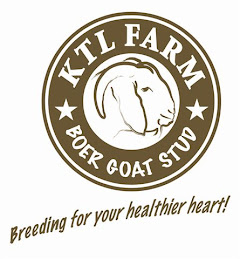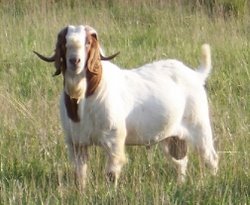1) Physiology of sperm production.
2) Nutrition.
3) Season.
4) Age of Bucks.
5) Fertility.
6) Mating Dexterity.
7) Female to male ratio.
8) Mating Systems.
9) Disease:
(a) Direct damage to the reproductive organs.
(b) Systemic disease indirectly causing infertility.
10) Pheromones.
Bucks with characteristics similar to the buck pictured above would make a good foundation for any herd
(1) Physiology.
It is important to note that a live, mature sperm takes about two months to develop. Any situation that compromises semen production will generally render the buck infertile for two months or more. If a buck is infertile at testing, one should remember that he may fully recover his fertility, but this can take two months or longer to occur.
(2) Nutrition.
Correct nutrition is one of the most important elements of any buck preparation programme. Any change in nutrition can result in a drastic change in semen quality. Bucks must not be fed too fat or be allowed to lose so much condition that they spend all their time foraging for food and do not do the job of mating the does.
There is a tendency the world over to over feed stud animals for stock shows. This type of over feeding often leads to temporary infertility. Also, very fat bucks are lazy and will not look for does to cover and are too fat and lazy to compete with well conditioned bucks.
(3) Season.
Goats are generally seasonal breeders with most sexual activity occurring with decreasing daylight length (i.e. autumn) and a lesser mating cycle in spring. In the Tropics, seasonal breeding is less pronounced. Boer goats will breed at any time of the year, but they also follow seasonal trends. Most kids are born in spring with the highest occurrence of multiple births also being in spring from the autumn mating.
It is very important to make sure that the bucks are sexually active and are calling and urinating all over themselves before they are presented to the does. If one thinks that they are inactive or slow, it is advisable to put a few old does that have been treated with oestrogens into the buck flock. This will even stimulate sexual activity in the bucks out of season. The sexually active bucks will then stimulate the doe flock to become sexually active.
(4) Age of Bucks.
It is desirable to use bucks of the same age in a mating system. It has happened that an older, dominant buck has been infertile in a flock and has fought off the younger bucks with disastrous results at kidding time.
In any mating system, the dominant bucks will mate most of the does. It is important to make sure that the bucks being used are big enough to mate the does they are with. One group of young bucks was observed to masturbate against the perineum of the females that were too tall and then collapse in a dazed heap after ejaculating in the air. The antics were hilarious to watch, but highly unproductive.
(5) Fertility.
It is very important to test bucks for genital soundness before mating commences particularly in single sire mating systems. It is much cheaper to make sure that a buck is genitally sound than it is to lose a crop of
kids. This procedure should be undertaken by a veterinarian who is properly skilled in this field.
(6) Mating dexterity and libido.
Bucks may be genitally sound, but may have no idea on how to copulate successfully. Most bucks learn very quickly what is required. It is important to note that they are mating correctly.
Another very important aspect is libido. A fit, healthy buck should be prepared to mate five to six times in an hour when does are first presented to him. This will decline over time. When does are presented to bucks, most of the females should be mated within the first three weeks of the breeding period. Bucks must have good libido and mating dexterity to achieve the desired results.
(7) Female to male ratio.
When preparing for the breeding season, it is important to know how many females each buck is expected to breed. One cannot expect a young, inexperienced buck to breed fifty females in six weeks (expect him to breed 25 – 35 does over this period).
The bigger the paddock and the more extensive a paddock is, the higher the buck to doe ratio must be to ensure that the animals find each other when the female is in oestrus.
(8) Mating Systems.
(a) Single Sire Mating.
It is essential to ensure that the buck is fertile, healthy, and sound and can mate properly if this system is employed. It is a good practice to change bucks half way through the breeding period to ensure that all the females are properly bred. This also minimizes the risk if a buck becomes infertile during the breeding period.
The advantage of this system is that the buck need not fight other bucks to mate does which saves his energy for mating. This also minimizes the risk of injury to the bucks.
(b) Multiple Sire mating.
In this system, it is desirable to use bucks of similar size and age. This decreases the risk of fighting injuries. The advantages are that fewer paddocks are required during breeding and bucks that get sick or injured are replaced by others in the flock.
(c) Artificial Insemination.
This is useful where one wants to breed a large number of females to one sire in a very short period. Make sure that the operator employed is experienced in dealing with goat artificial insemination.
(9) Disease.
This can be divided into two entities:-
(a) Direct damage to the reproductive organs.
(b) Systemic disease which may result in infertility.
(a) Direct Damage:
(i) Physical abnormalities present since birth e.g. short penis, cryptorchidisim.
(ii) Physical damage to the penis and testes e.g. while fighting, jumping over barbed wire fences etc.
(iii) Abcesses on the testes or prepuce. Most abcesses are caused by tick bites or puncture wounds which become infected by Corynebacterium (Cheesy gland). Abcesses cause infertility by occluding the preputial opening so that the penis cannot come out. Abcesses within the scrotum may interfere with the testicular blood supply which in turn affects the temperature regulating mechanism of the testes resulting in infertility which may be temporary or permanent.
(iv) Epididymitis from infections causes: e.g. Brucella ovis, Actinabacillus seminis. This is often transmitted during the breeding season and can result in very poor conception rates. More importantly, the damage these diseases cause to the ram flock as a whole can be devastating with resultant poor conception rates and high culling rate of rams.
(v) Orchitis – a severely inflamed testicle can result in permanent or temporary infertility.
(b) Systemic Disease resulting in Infertility.
(i) It is important to remember that any disease which causes a high fever can affect the temperature of the testes and this can cause temporary infertility which may last for two to three months. It is therefore important to know that the bucks are fertile and producing good semen at the beginning of the mating season.
(ii) Debilitating diseases (e.g.
(10) Pheromones.
The Pheromones play an extremely important role in stimulating female goats into sexual activity. It is very desirable that the bucks are sexually active and “stink to high heaven” when they are introduced to the female flock.
It is good practice to introduce vesectomized teaser bucks to a flock of does two weeks before the entire bucks to stimulate the female sexual activity. Females that are not stimulated by smelly, sexually active bucks may not cycle well even if it is the normal breeding season.
Jean van Niekerk
Phone: 03-58895123
Fax: 03-58895115
Mob: 0428569915
Email: jeanvanniekerk@gmail.com


